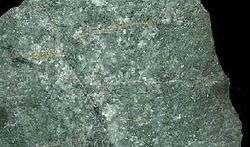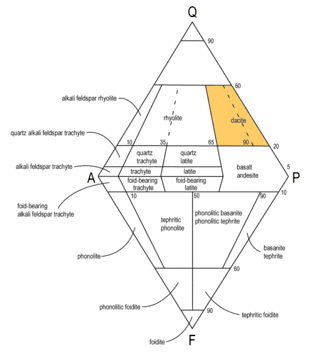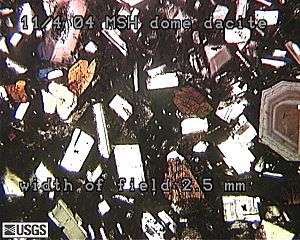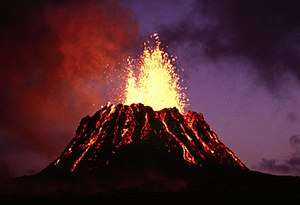Dacite
Dacite ( /ˈdeɪsaɪt/) is an igneous, volcanic rock. It has an aphanitic to porphyritic texture and is intermediate in composition between andesite and rhyolite. The word dacite comes from Dacia, a province of the Roman Empire which lay between the Danube River and Carpathian Mountains (now modern Romania and Moldova) where the rock was first described.

The term dacite was introduced in the scientific literature by the Austrian geologist Guido Stache, and used for the first time in the book Geologie Siebenbürgens (The Geology of Transylvania)[1]. The reason to designate a new igneous rock type was to discriminate between the oligoclase-bearing rocks (dacites) and the orthoclase-bearing rocks (rhyolites) on petrographic grounds. The type-locality of dacite is near the village of Poieni, Cluj(Gizella quarry) located along the Crișul Repede river, Vlădeasa Massif in the northern Apuseni Mountains, Romania.[2]
Composition

Dacite consists mostly of plagioclase feldspar with biotite, hornblende, and pyroxene (augite and/or enstatite). It has quartz as some rounded, corroded phenocrysts, or as an element of the ground-mass.[3] The relative proportions of feldspars and quartz in dacite, and in many other volcanic rocks, are illustrated in the QAPF diagram. The TAS classification, based on silica and alkali contents, puts dacite in the O3 sector. The plagioclase ranges from oligoclase to andesine and labradorite. Sanidine occurs, although in small proportions, in some dacites, and when abundant gives rise to rocks that form transitions to the rhyolites.
The groundmass of these rocks is composed of plagioclase and quartz.
Texture
In hand specimen, many of the hornblende and biotite dacites are grey or pale brown and yellow rocks with white feldspars, and black crystals of biotite and hornblende. Other dacites, especially pyroxene-bearing dacites, are darker colored.[3]
In thin section, dacites may have an aphanitic to porphyritic texture. Porphyritic dacites contain blocky highly zoned plagioclase phenocrysts and/or rounded corroded quartz phenocrysts. Subhedral hornblende and elongated biotite grains are present. Sanidine phenocrysts and augite (or enstatite) are found in some samples. The groundmass of these rocks is often aphanitic microcrystalline, with a web of minute feldspars mixed with interstitial grains of quartz or tridymite; but in many dacites it is largely vitreous, while in others it is felsitic or cryptocrystalline.
Geological context and formation

Dacite usually forms as an intrusive rock such as a dike or sill. Examples of this type of dacite outcrop are found in northwestern Montana and northeastern Bulgaria. Nevertheless, because of the moderately high silica content, dacitic magma is quite viscous[4] and therefore prone to explosive eruption. A notorious example of this is Mount St. Helens in which dacite domes formed from previous eruptions. Pyroclastic flows may also be of dacitic composition as is the case with the Fish Canyon Tuff of La Garita Caldera.[5]
Dacitic magma is formed by the subduction of young oceanic crust under a thick felsic continental plate. Oceanic crust is hydrothermally altered causing addition of quartz and sodium.[6] As the young, hot oceanic plate is subducted under continental crust, the subducted slab partially melts and interacts with the upper mantle through convection and dehydration reactions.[7] The process of subduction creates metamorphism in the subducting slab. When this slab reaches the mantle and initiates the dehydration reactions, minerals such as talc, serpentine, mica and amphiboles break down generating a more sodic melt.[8] The magma then continues to migrate upwards causing differentiation and becomes even more sodic and silicic as it rises. Once at the cold surface, the sodium rich magma crystallizes plagioclase, quartz and hornblende.[9] Accessory minerals like pyroxenes provide insight to the history of the magma.
The formation of dacite provides a great deal of information about the connection between oceanic crust and continental crust. It provides a model for the generation of felsic, buoyant, perennial rock from a mafic, dense, short-lived one.
Dacite's role in the creation of Archean continental crust
The process by which dacite forms has been used to explain the generation of continental crust during the Archean eon. At that time, the production of dacitic magma was more ubiquitous, due to the availability of young, hot oceanic crust. Today, the colder oceanic crust that subducts under most plates is not able to melt prior to the dehydration reactions, thus inhibiting the process.[10]
Molten dacite magma at Kīlauea
Dacitic magma was encountered in a drillhole during geothermal exploration on Kīlauea in 2005. At a depth of 2488 m, the magma flowed up the wellbore. This produced several kilograms of clear, colorless vitric (glassy, non-crystalline) cuttings at the surface. The dacite magma is a residual melt of the typical basalt magma of Kīlauea.[11]
Distribution
Dacite is relatively common and occurs in various tectonic and magmatic contexts:
- In oceanic volcanic series. Examples: Iceland (Heiðarsporður ridge),[12] Juan de Fuca Ridge[13]
- In limestone-alkaline and tholeiitic volcanic series of the subduction zones of island arcs and active continental margins. Examples of dacitic magmatism in island arcs are Japan, the Philippines, the Aleutians, the Antilles, the Sunda Arc (Mount Batur),[14] Tonga and the South Sandwich Islands. Examples of dacitic magmatism in active continental margins are the Cascade Range, Guatemala and the Andes (Ecuador and Chile).
- In continental volcanic series, often in association with tholeiitic basalts and intermediary rocks.
Sites of dacite in Europe are Germany (Weiselberg in the Saarland), Greece (Nisyros and Thera), Italy (in Bozen quartz porphyry, and Sardinia), Austria (Styrian Volcano Arc), Romania (Transylvania), Scotland (Argyll),[15] Slovakia, Spain (El Hoyazo near Almería),[16] France (Massif de l'Esterel)[17] and Hungary (Csódi Hill).[18]
Sites outside Europe include Iran, Morocco, New Zealand (volcanic region of Taupo), Turkey, USA and Zambia.
Dacite is found extraterrestrially at Nili Patera caldera of Syrtis Major Planum on Mars.[19]
See also
- Lassen Volcanic National Park – National park of the United States
- Potosí – city in Bolivia
References
| Wikimedia Commons has media related to Dacite. |
- https://ia600909.us.archive.org/18/items/bub_gb_CYwAAAAAcAAJ/bub_gb_CYwAAAAAcAAJ.pdf
- https://adatbank.transindex.ro/vendeg/htmlk/pdf6037.pdf.
-

- Whittington, A. G.; Hellwig, B. M.; Behrens, H.; Joachim, B.; Stechern, A.; Vetere, F. (2009). "The viscosity of hydrous dacitic liquids: implications for the rheology of evolving silicic magmas". Bulletin of Volcanology. 71 (2): 185–199. Bibcode:2009BVol...71..185W. doi:10.1007/s00445-008-0217-y.
- "Outflow ignimbrite sheet of Fish Canyon Tuff: crystal-rich dacitic ignimbrite erupted from La Garita caldera" (PDF). USGS. Retrieved 16 August 2015.
- Devore, G. W. (1983). "The influence of submarine weathering of basalts on their partial melting during subduction". Lithos. 16 (3): 203–213. Bibcode:1983Litho..16..203D. doi:10.1016/0024-4937(83)90024-5.
- Drummond, M. S.; Defant, M. J. (1990). "A model for Trondhjemite-Tonalite-Dacite Genesis and crustal growth via slab melting: Archean to modern comparisons". Journal of Geophysical Research. 95 (B13): 21503–21521. Bibcode:1990JGR....9521503D. doi:10.1029/JB095iB13p21503.
- Fyfe, W.; McBirney, A. (1975). "Subduction and the structure of andesitic volcanic belts". American Journal of Science. 275-A: 285–297.
- Defant, M. J.; Richerson, P. M.; de Boer, J. Z.; Stewart, R. H.; Maury, R. C.; Bellon, H.; Drummond, M. S.; Feigenson, M. D.; Jackson, T. E. (1991). "Dacite Genesis via both Slab Melting and Differentiation: Petrogenesis of La Yeguada Volcanic Complex, Panama". Journal of Petrology. 32 (6): 1101–1142. Bibcode:1991JPet...32.1101D. doi:10.1093/petrology/32.6.1101.
- Atherton, M. P.; Petford, N. (1993). "Generation of sodium-rich magmas from newly underplated basaltic crust". Nature. 362 (6416): 144–146. Bibcode:1993Natur.362..144A. doi:10.1038/362144a0.
- Puna Dacite Magma at Kilauea: Unexpected Drilling Into an Active Magma Posters, 2008 Eos Trans. AGU, 89(53), Fall Meeting
- Mancini, A.; Mattsson, H.B.; Bachmann, O. (2015). "Origin of the compositional diversity in the basalt-to-dacite series erupted along the Heiðarsporður ridge, NE Iceland". Journal of Volcanology and Geothermal Research. 301: 116–127. Bibcode:2015JVGR..301..116M. doi:10.1016/j.jvolgeores.2015.05.010.
- Perfit, M.R.; Schmitt, A.K.; Ridley, W.I.; Rubin, K.H.; Valley, J.W. (2008). "Petrogenesis of dacites from the southern Juan de Fuca Ridge". Goldschmidt Conference Abstracts 2008. Goldschmidt Conference 2008. Retrieved 23 February 2018.
- Wheller, Graeme Eric (1986). Petrogenesis of Batur caldera, Bali, and the geochemistry of Sunda-Banda arc basalts. PhD thesis, University of Tasmania.
- Ellis, R. A.; et al. (1977). lnvestigation of disseminated copper mineralisation near Kilmelford, Argyllshire, Scotland (Mineral Reconnaissance Programme Report 9) (PDF). London: Institute of Geological Sciences.
- Acosta-Vigil, Antonio; Buick, Ian; Cesare, Bernardo; London, David; Morgan, VI, George B. (2012). "The Extent of Equilibration between Melt and Residuum during Regional Anatexis and its Implications for Differentiation of the Continental Crust: a Study of Partially Melted Metapelitic Enclaves". Journal of Petrology. 53 (7): 1319–1356. Bibcode:2012JPet...53.1319A. doi:10.1093/petrology/egs018.
- Thomas, Pierre (May 2016). "Dacite (Esterellite)". Observer les objets géologiques (in French). Lithothèque ENS de Lyon. Retrieved 23 February 2018.
- "Dacite" (PDF). Hungarian Natural History Museum. Retrieved 23 February 2018.
- "Nili Patera and Dacite Lava Flow". Mars Exploration – Multimedia. NASA. 1 April 2012. Retrieved 9 August 2017.
